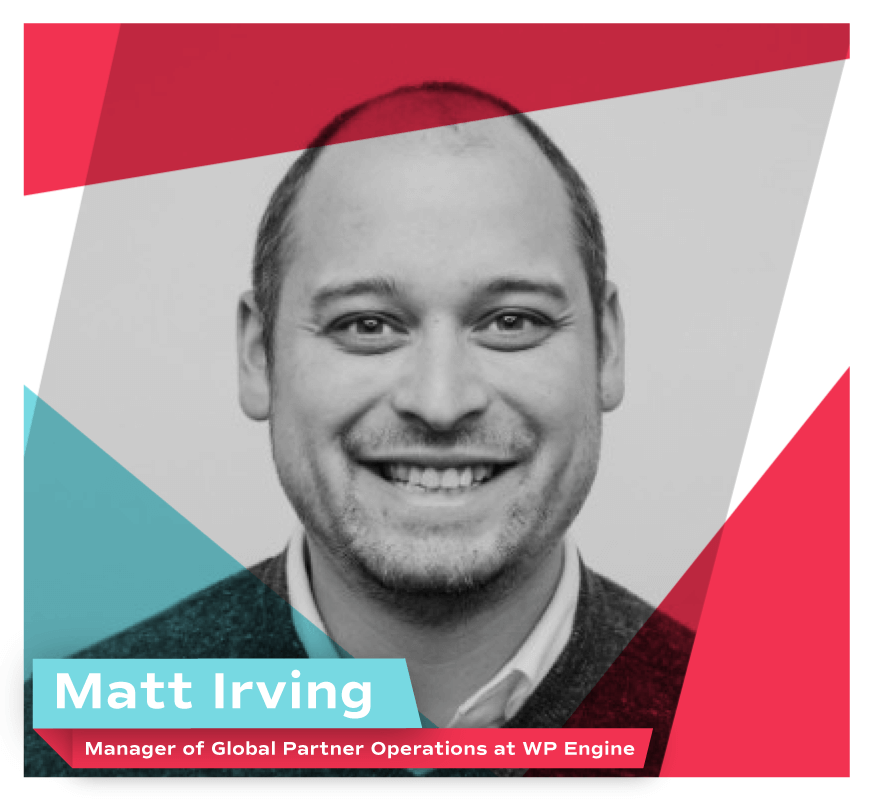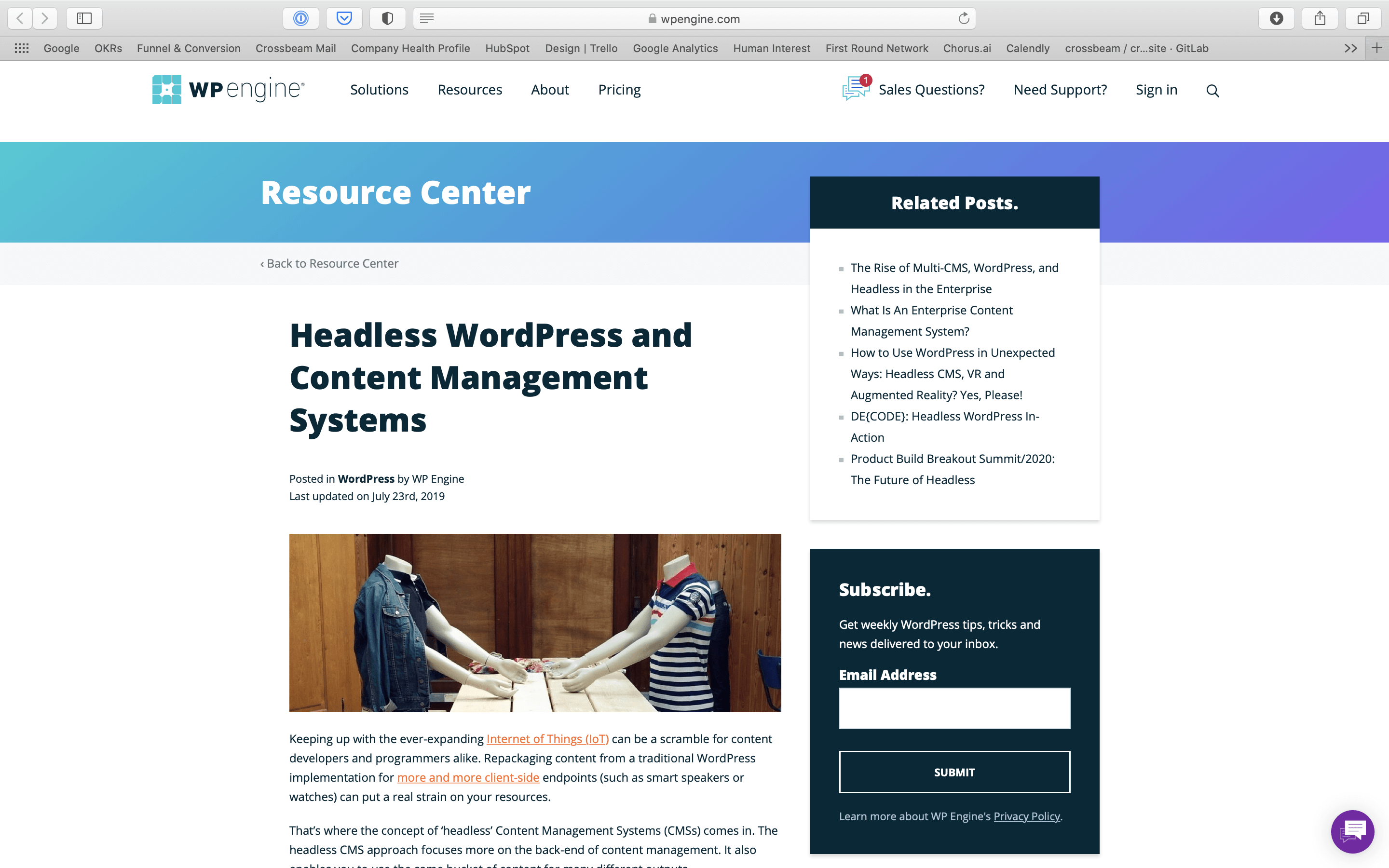You’re churning out partner program guides, sales one-pagers, and technical documentation left and right, but you still aren’t seeing traction from your partners. They’re disinterested and you’re clearly not a priority for them. If this sounds all too familiar, here’s some advice: Stop what you’re doing and get off the treadmill.
Rather than trying to do it all, it’s time to reset and refocus so that you invest your time on tactics that actually solve your partners’ problems — and it all starts with implementing a thoughtful partner enablement process.
Done correctly, a partner enablement process can have a profound effect on your ecosystem. Just ask the team over at WP Engine, the WordPress’ digital experience platform. Their partner enablement process has helped them grow WP Engine’s agency partner program by 8X in its first two years of operation.
We chatted with WP Engine’s Matt Irving, Manager of Global Partner Operations, and Tony Gilharry, Senior Partner Enablement Manager, to learn their process for prioritizing and building enablement for 5,000+ global agency partners — a process that’s yielded results:
“40% of our agency partners who actually take on training end up referring in the first 30 days,” says Gilharry.
In this post, we’ll cover how to:
- Define What Partner Enablement Means to You
- Conduct a Partner Enablement Discovery Phase
- Build and Prioritize Your Enablement Backlog
Define What Partner Enablement Means to You
 “[Enablement] means so many different things to so many different people, and that includes internal stakeholders and external stakeholders,” says Gilharry.
“[Enablement] means so many different things to so many different people, and that includes internal stakeholders and external stakeholders,” says Gilharry.
Someone on your team might view enablement as self-service content while your partner might expect hands-on workshops and 1:1 coaching from you. Think about how you define enablement and the expectations you’ll want to set with your partners and those on your team.
Irving applies this mindset: “How do you help a third party understand where you are better together than independently? And then it’s thinking about how do you translate that not only in terms of the value that’s being delivered, but also where is that value being delivered across the customer lifecycle?”
Conduct a Partner Enablement Discovery Phase
During the discovery phase, your job is to understand where friction exists when you work with your partners and when your partners work with your customers. It’s your chance to gather internal and external stakeholders’ perspectives, data points, and expectations — all of which will inform how you prioritize and build enablement content and curriculum (more on that later).

1. Audit Your Internal Stakeholders
Meet with internal stakeholders (e.g. sales, customer success, and product) who interact with partners and customers to understand the following:
- What kinds of questions are prospects and customers asking partners?
- What issues are partners running into?
- What are common questions from partners?
- What are common support tickets that come up during pre-sales processes?
- What feature requests are you getting from partners and customers? And what are they trying to do with that feature?
- What use cases are you hearing about regularly?
 Irving says, “You need to be able to understand what you’re solving for and who needs it. That helps you assess: How much of this training do I have internally that I can just give it externally? How much of this stuff is brand new? How much of this stuff would be great to have, but we don’t really have anyone asking for it yet?”
Irving says, “You need to be able to understand what you’re solving for and who needs it. That helps you assess: How much of this training do I have internally that I can just give it externally? How much of this stuff is brand new? How much of this stuff would be great to have, but we don’t really have anyone asking for it yet?”
Asking these questions will help you determine how you can support partners and help them overcome challenges. It also helps you understand where you might need to engage other stakeholders, like your product team or even another partner in your ecosystem. “You’re not going to be able to answer every question and you’re not going to be able to fit every use case,” says Irving.
For example, in a previous role at another SaaS company, Irving received multiple requests from partners for a subscription billing feature. Knowing that his team wasn’t going to build that feature, Irving turned to his partner ecosystem for backup. The result? A solved use case for his company’s partners as well as stronger partnerships with companies like Recurly, Stripe, and others.
2. Get Feedback from External Stakeholders
Talk to partners and customers to understand what they’re solving for, and where there might be gaps in technical or product knowledge or messaging and positioning.
Irving and Gilharry say you can do this a few ways:
- Sift through sales rep activity, chats, and direct conversations with partners to understand what interactions and conversations are happening.
- Conduct surveys (via tools like Mailchimp or SurveyMonkey) to consolidate learnings and feedback.
- Facilitate focus groups with partners to discuss specific topics like onboarding, incentives, messaging, etc.
You’ll not only learn what partners are asking for, but your findings might also reveal hidden pain points or challenges that partners aren’t quite articulating. “The direct ask isn’t often what they need the most,” says Irving.
In the past, partners have asked Irving and his team, “How do I tell my IT people when our WordPress site is down?” While that question can easily be answered, it’s a reactive question not a proactive one. Irving sensed the real question was, “How do I ensure that my site is up and that my team is always aware of it?”
By asking, “What are you solving for?” vs. “What do you want?” you’ll be able to suss out the outcomes your partners are trying to achieve and understand their line of thinking.
Build and Prioritize Your Enablement Backlog
Once you’ve gathered your findings, Irving suggests creating a backlog to catalog those items and add a column to note the frequency for each question or issue. Plan, prioritize, and develop your enablement content and curriculum the same way you would for a new product.
Here’s an example of what a backlog could look like.
Question/Issue | Frequency | Type | Asset |
How do I get paid? | 12 | Existing content | |
How can I monetize a maintenance program? | 9 | Net New Content | |
My customers keep asking about our experience with migrations | 7 | Net New Content |
You’ll find that your backlog items will fall into one of these four buckets:
Bucket #1: Requires Net New Content
These are common questions that can be answered only with net new content. This is the content that can be packaged into an FAQ guide or page, a video, or a training workshop. By monitoring the frequency of these questions, you’ll know how to prioritize content creation. In some cases, you can tag your partner to create the content.
For example: When WP Engine realized they needed new content to help resellers understand how they could potentially work together, they teamed up with one of their agencies to create something brand new. WP Engine and Alaniz Marketing, a multi-channel marketing agency, hosted a joint webinar, “How to Build a Six-Figure Website Maintenance Program,” to offer step-by-step guidance to other agency partners.
Bucket #2: Requires Internal Product/Engineering Expertise
These are the questions and issues that you need to address with the product/engineering team. “I think with product and engineering expertise, you’re trying to get your product teams’ and customers’ heads nodding to the same thing,” says Irving.
For example, WP Engine is currently exploring Headless, a website architecture, as a market opportunity. To gauge partners’ interest and build alignment with the product team, Irving and team are putting out feelers via thought leadership content like articles and Ebooks.
Bucket #3: Can Be Repurposed Via Existing Content
These are the questions that are already answered in existing training materials and content for internal team members — they just need to be repurposed for a different audience. No need to reinvent the wheel if you don’t have to.
In these scenarios, the WP Engine team will often take evergreen content like a blog post, refresh it, and then repurpose it into different formats like an infographic or a webinar.
Bucket #4: Requires Ecosystem Support
These are the questions and issues that fall outside of you and your partners’ scope — the questions that you don’t have an answer for.
Irving suggests asking yourself, “Are we the best people to answer these questions or can we develop an ecosystem of partners to kind of help them coach and train each other where we facilitate it?”
WP Engine often has customers migrating over to WordPress from another platform. Rather than building out an import tool, the WP Engine team turns to the ecosystem. “We could build that professional service, but we could actually partner with people who do that way better than us… maintain those importers and then also build some services around it,” says Irving.
“Partner programs are really just facilitators of ecosystems,” he says. (We couldn’t agree more.)
–
Use your prioritized backlog as an actionable blueprint to guide your enablement content calendar and curriculum development.
And remember: The partner enablement discovery process and partner enablement backlog don’t have to be a one-time exercise. Treat your partner enablement process like a product — one that you’re constantly baking stakeholder input into and iterating upon.
“We call it ‘enablement as a product’ because it’s continuous and you’re always going to have to iterate on the process because things change so often,” says Gilharry.






This is a test comment.
This is a longer test comment to see how this looks if the person decides to ramble a bit. So they're rambling and rambling and then they even lorem ipsum.